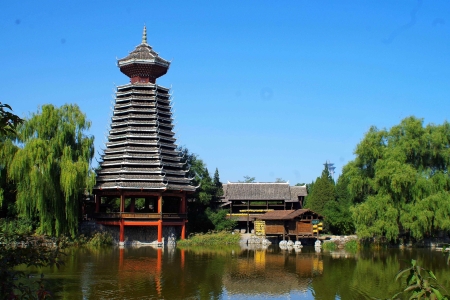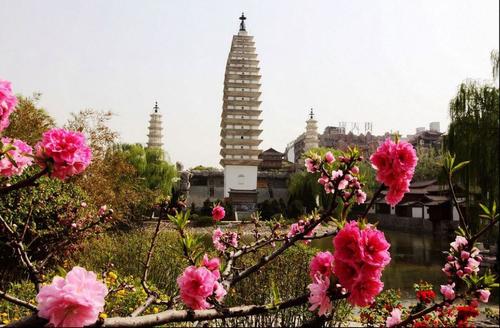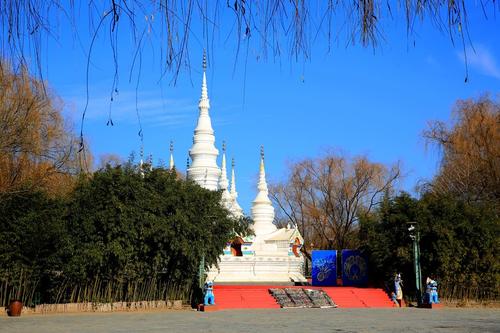Chinese Name: 中华民族园 Pronunciation: Zhōnghuá Mínzúyuán
Building Time: 1992
Suggested Visiting Hours: 3-4 Hours
Occupied Area: About 500,000 square meters
Address: No.1, Chinese Ethnic Culture Park Road, Chaoyang District, Beijing, China
| Tourists | Ticket Price |
| Adults | 90 yuan |
| Seniors (aged 60 to 79) |
65 yuan |
1. Visitors need to make online reservations in advance.
2. Currently, only the North Park is open between 8:30 and 17:00. The tickets during this period are priced at 45 yuan.
3. The fare for the Tibetan Mandala Altar is 2 yuan per person.
4. The tickets are not refundable.
One adult is allowed take one child under 1.3 meters or under 6 years old or one senior above 80 years old with valid certification for free.
| Park |
Peak Season
(March 15th-November 15th)
|
Low Season
(November 16th-March 14th)
|
| Gate Opening Hours | 09:00-17:00 | 08:30-17:00 |
| Ticket Office Opening Hours | 09:00-17:00 | 08:30-17:00 |

The Chinese Ethnic Culture Park, also known as the Chinese Ethnic Museum, covering an area of 50 hectares, is a large anthropological museum that restores, collects, displays, and studies the culture, cultural relics, and social life of the 56 nationalities in China. It has a collection of about 100 thousand cultural relics and articles, such as ethnic costumes, tools of production, articles for daily use, transportation tools, and religious articles.
The theme exhibitions are mainly about theme collections exhibitions, picture exhibitions, theme ethnic exhibitions. The way of the exhibition is divided into the dynamic exhibition and the static exhibition. The dynamic exhibition shows the ethnic costumes, songs and dances, crafts, festivals, bite and sup, and sports; the static exhibition includes three aspects: ethnic dwellings, towers and temples, and basic and special exhibitions.
The Chinese Ethnic Culture Park is composed of two parts: North Park and South Park. The park includes exhibition halls, distinctive ethnic architecture, and gardens. The exhibition halls are the Main Exhibition Hall and Ethnic Exhibition Villages.
The Main Exhibition Hall, located in the South Park, represents some theme exhibitions reflecting the production and life of Chinese ethnic groups and their cultural and historical remains. The exhibitions are about the ancestral hall, post house, boatyard, boudoir, study room, baby breeding room, etc.

Each ethnic nation is displayed in a village, which is in imitation to the real ethnic one in the proportion 1:1. You may walk in a courtyard, a street, or even a dam enjoying trees, flowers, and crops, which are planted according to the environmental features of the ethnic groups. These ethnic exhibition villages feature independent architectural buildings of each ethnic group and are rich in ethnic culture connotation.
The South Park includes Bai, Yao, Zhuang, Tujia, and other ethnic villages, except for which, the other spot sights are also worthy of visiting. The Triple Tower of Dali, for example, is the replication of a tower in Chongsheng Temple at a ratio of 0.7:1. Jianchuan Grottoes is an imitation of Shizhongshan Grottoes in Jianchuan County, Yunnan Province. The Opera Stage of Bai is the copy of an ancient stage located in Shaxi Town, Jianchuan County of Yunnan Province.
In North Park, the 16 ethnic villages include Tibetan, Miao, Yi, Dong, Taiwan Gaoshan, etc. The Totem Pole, the first large iron-cast totem pole in China, is located close to the entrance of the North Park. Visitors can also enjoy the landscapes of tropical rainforest, karst cave, and Panlong Waterfall.
The art troupe prepares three sets of ethnic rhythmic exercise absorbing dance movements of eight ethnic groups (Tibetan, Mongol, Naxi, Tujia, Bai, Yi, Wa, and Mosuo). In the morning, 160 minority performers wearing the costumes of 56 ethnic groups perform the dances.

Ethnic sports are displayed in nine ethnic villages: Mongol, Miao, Wa, Tujia, Bai, Naxi, Jingpo, Tibetan, and Dai. Visitors can join the performers to participate in a variety of activities, such as Climbing Onto Knives Mountain(a characteristic acrobatic performance in Miao Nationality), tug of war, flying spinning top, bamboo pole dance, pushing iron hoop, kicking shuttlecock, diabolo performance, Mongolian wrestling, and so on.
In the ethnic villages, visitors can not only enjoy but also take part in the activities of ethnic singing and dancing, celebrations and festivals, production etc. The whole park is an open-air museum of humanities for Chinese ethnic nations integrating ethnic architectures, cultural collections, and song and dance shows.
The construction of the Chinese Ethnic Culture Park began in 1992. The North Park was opened to the public on June 18, 1994, and the South Park was opened on September 29, 2001.

The 56 groups of buildings of all ethnic groups in China, including residential buildings, religious buildings, and landscape buildings, copied and restored here, are important parts of the Chinese Ethnic Culture Park. The architectural patterns cover all typical patterns of Chinese traditional architecture, such as cave dwelling, single courtyard, patio-pattern, Diaojiaolou (rectangular or square wooden buildings supported by stilts or wood columns), tent-pattern, tower-pattern.
When visitors observe and compare the buildings with other architecture, it will be noticed that different social forms, religious beliefs and geographical environments in China make all ethnic groups coexist with diverse social structures and economic forms, which make the buildings of all ethnic groups have obvious differences in shape, building materials and techniques.
Please protect the ethnic cultural heritage and respect the customs of ethnic minorities.
Please observe the customs and habits of the Dai people when participating in the activity of the Dai Water Splashing Festival.
Please pay attention to your personal safety and do not run on the wet ground to avoid slipping and falling.
The North Park: Tibetan Museum→ Lhoba Museum→ Dai Museum→ Monba Museum→ Qiang Museum→ Tu Museum→ Taiwan Ethnic Groups Museum→ Achang Museum→ Miao Museum→ Yi Museum→ The Earth Forest→ Dragon Lake Scenery
The South Park: Tujia Museum→ Zhuang Museum→ Mongol Museum→ Uygur Museum→ Hui Museum→ Main Exhibition Hall→ Triple Tower of Dali→ Phoenix Lake Scenery
Take bus 607 and get off at Chinese Ethnic Culture Park Station. After getting off, you need to walk northward about 140 meters along the Beichenlu(Beichen Road), go across one road and turn left into Minzuyuanlu(Ethnic Culture Park Road), walk about 40 meters, turn right, walk about 20 meters, turn left, walk about 90 meters to the destination.
Take bus 55 or 113 and get off at Ethnic Culture Park West Road Station. After that, you need to walk eastward for 120 meters along the Minzuyuan Xilu(Ethnic Culture Park West Road) into Minzuyuanlu(Ethnic Culture Park Road), walk about 180 meters, turn left, walk 20 meters, turn right, walk about 190 meters to the destination.
Take Metro Line 8 and get off at Olympic Sports Center Station (Exit D). Walk southward for 250 meters, turn left, walk 20 meters, turn right rear into Minzuyuanlu(Ethnic Culture Park Road), walk 40 meters, turn right, walk 20 meters, turn left, walk about 90 meters to the destination.
Chinese: 请带我去中华民族园。English: Please take me to the Chinese Ethnic Culture Park.
If you go to the Chinese Ethnic Culture Park from the center of Beijing (Grand Hyatt Beijing), it takes about 30 minutes (about 40 yuan).
If you go to the Chinese Ethnic Culture Park from Beijing Capital International Airport, it takes about 35 minutes (about 90 yuan).
If you go to the Chinese Ethnic Culture Park from Beijing Daxing International Airport, it takes about 1.2 hour (about 220 yuan).
If you go to the Chinese Ethnic Culture Park from Beijing West Train Station, it takes about 25 minutes (about 50 yuan).
